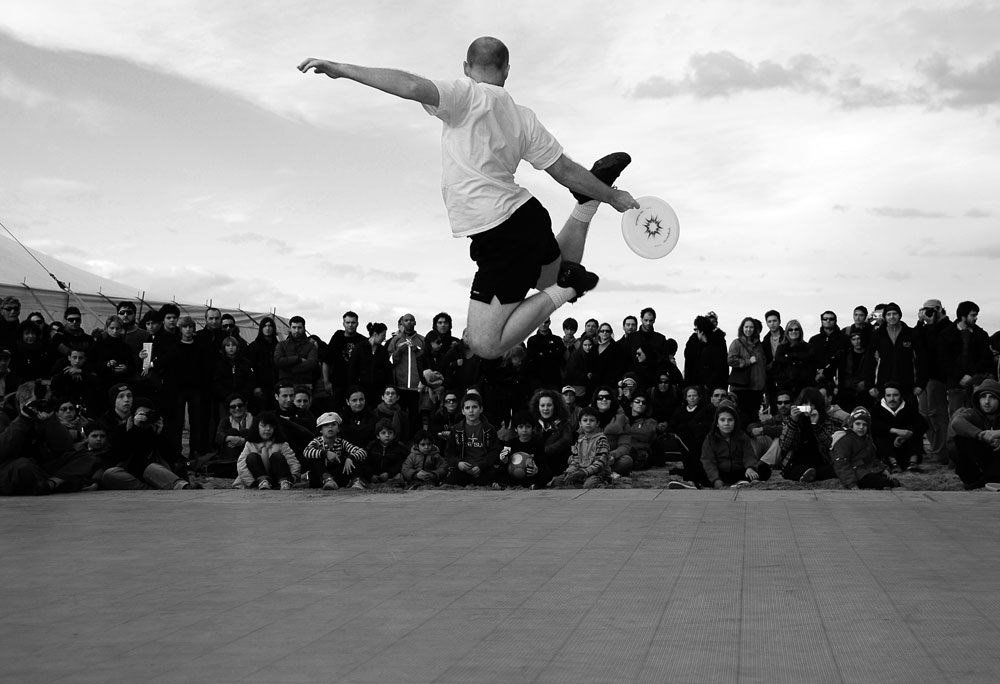American swimmer Katie Ledecky is rewriting the record books of women’s distance swimming. This week, she set two world records at the Pan Pacific Swimming Championships. The Olympic gold medalist is not just winning races, she is making people rethink what is possible. This summer, she has set five world records. In the last year, taken 16 seconds off the world record in the 1500m freestyle.
Extraordinary Goals Redefine What’s Possible
Ledecky is a phenomenon, a spectacular talent, and we can learn about goal setting by watching her performances. Her world records are check-ins on her training. She’s building toward these mindboggling times. They are intentional. Unlike most athletes, she is not aiming at incremental improvement. At some point, she and her coach realized how much upside was available and set extraordinary, revolutionary goals.
In my sport, I’m known for doing tumbling moves. I’ll spin the disc on my finger, pop it up, spin around, do a somersault and get the disc spinning back on my finger. I learned that move – and the double spinning tumble – from watching another top player, Dave Murphy. Once I got used to that move, I imagined an entire family of moves beyond my existing skill level. How about a triple spinning tumble? What if I did more difficult tricks after the somersault, like a very technical trick called The Juice. What about doing the tumbles directly from restricted moves like a behind the back set or a pass we call the Yogi? What about a quadruple spinning tumble?
Thinking of these moves created extraordinary goals. Once I imagined them, they became possible. From that moment on, freestyle was not just about getting better at the expected. It was about claiming new territory. I began to figure out the training and skills needed to make these ideas real. The training plan emerged from the idea, and the training plan was more ambitious than before. All those ideas became real moves, and I trained many of them well enough to try in competition. Here’s a triple spinning tumble from a beach session a few years ago:
The Goal Creates The Plan
Back to Katie Ledecky. She’s training toward the 2013 season. The six-year old world record is 15:42.54 by Kate Ziegler. She realizes not only that she can break it but that she can reset the standard. She doesn’t train for 15:42.53. That’s not worthy of her vision. She trains to destroy the record and does just that. She takes 9 seconds off Ziegler’s time.
Cool. Now what? The best time to consolidate your greatness is after a big victory, when most people would be resting on their laurels. She reimagines reality. The new record is 15:36.53. She sets her sights way beyond that for 2014 and gets to work. People are amazed when she takes another two seconds off the world record at meet in June, but it’s just a glimpse of what she’s been training toward. Two months later, we see the next payoff of her training at the Pan Pacific Championships with this new world record: 15:28.36. No man had swum that fast until 1975. It would have placed 18th in the men’s 1500m race at this year’s US Championships. Extraordinary goal for 2014 completed!
I don’t know whether Ledecky is scheduled to swim any more races this year, but I can’t wait to see how she redefines her own potential. Whether or not she hits her goal, the goal will be huge and confident and courageous.
Applying Extraordinary Goals Outside Sports
As sports fans we cheer for achievements like Ledecky’s. What we don’t do often enough is apply sports lessons to our everyday lives. But if we look to community and business leaders, we can see extraordinary goals in action.
Elon Musk imagined a world where electric vehicles are the standard, and we’re seeing him pursue that vision. The success of Tesla vehicles was only one chapter of his plan. We’re beginning to see that they are part of a complete reimagining of transportation infrastructure.
The fight for marriage equality shows us how extraordinary goals become reality in society. For most people, same sex marriage was an alien concept until very recently. But for the leaders of the marriage equality movement, it was an idea. A seemingly impossible idea, but one that they as leaders could not betray. By imagining marriage equality, however improbable, they set the wheels in motion. And here’s the important part: it didn’t succeed at first. Just having an extraordinary idea does not guarantee its success. I can imagine swimming faster than Katie Ledecky, but all it guarantees is that my personal likelihood of achieving that goal just increased by some unmeasurable amount. It became possible, not guaranteed or even probable until I create the right plan and execute on it. Progress toward marriage equality included setbacks, and the action plan toward this extraordinary goal evolves with each piece of new data.
Think about your skills, your projects, your aspirations. What are you aiming for now, and what ridiculously bigger result could you imagine. What new territory are you willing to claim? Now, what would it take to get there? Remember, you already made a good portion of the journey just by imagining a bigger goal. How would it feel to experience that huge result? How would it change things to embrace the ridiculous and go after it?

